French 19th Century Painting of a Middle Class Family
| Félix Vallotton | |
|---|---|
 Self-portrait (1897) | |
| Born | Félix Edouard Vallotton December 28, 1865 Lausanne, Switzerland |
| Died | Dec 29, 1925 (aged 60) Neuilly-sur-Seine, Paris |
| Nationality | Swiss/French |
| Education | École des Beaux-Arts, Académie Julian |
| Known for | Painting, woodcuts |
Félix Edouard Vallotton (December 28, 1865 – Dec 29, 1925) was a Swiss and French painter and printmaker associated with the group of artists known every bit Les Nabis . He was an important figure in the development of the modern woodcut. He painted portraits, landscapes, nudes, still lifes, and other subjects in an unemotional, realistic fashion.
His earliest paintings were influenced by Holbein and Ingres. He developed a simpler style during his association with Les Nabis during the 1890s, and produced woodcuts which brought him international recognition. Characterized by broad masses of black and white with minimal particular, they include street scenes, bathers, portraits, and a series of 10 interiors titled Intimités (Intimacies) that portray charged domestic encounters between men and women. He produced few prints after 1901, and concentrated instead on painting. His later on paintings include highly finished portraits and nudes, and landscapes painted from memory.
He was also active as a writer. He published art criticism during the 1890s, and his novel La Vie meurtrière (The Murderous Life) was published posthumously.
Early life [edit]
Vallotton was built-in into a conservative middle-class family unit in Lausanne, the 3rd of four children. His male parent endemic a pharmacy, and afterward purchased a chocolate mill. His mother, Emma, was the daughter of a article of furniture craftsman. His family unit environment was warm but strict, in the Swiss Protestant tradition. Beginning in 1875 he attended the Collège Cantonal, graduating with a degree in classical studies in 1882. He also began to attend the drawing classes of the painter Jean-Samson Guignard, normally reserved for almost avant-garde students, where he showed a detail skill in close observation and realism. When he completed the grade, he persuaded his parents to let him go to Paris to study fine art seriously.[ane]
In January 1882 he settled in Rue Jacob in the neighborhood of Saint-Germain-des-Prés, and enrolled in Académie Julian, where he studied with the portrait painter Jules Joseph Lefebvre and the history painter Gustave Boulanger, and where he perfected his technical skills. He spent many hours in the Louvre, and he greatly admired the works of Leonardo da Vinci, Holbein, Dürer, and more modern painters, including Goya and Manet, and especially Ingres, whose works were models for Vallotton throughout his life.[ii]
In 1883, Vallotton's father wrote to Lefebvre, questioning whether his son could brand a living as a painter. Lefebre responded that the young Vallotton had the talent and power to succeed. In the aforementioned year, Vallotton succeeded in the rigorous contest to enter the École des Beaux-Arts, only decided instead to remain at the Académie Julian, where his friends were. He besides began to frequent the cafés and cabarets of Montmartre.[three]
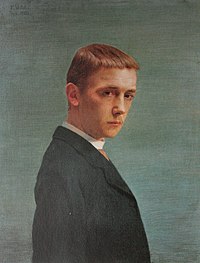
Self-portrait at 20 years erstwhile, oil on canvas (1885)
In 1885 the methodical Vallotton began keeping a notebook, called his Livre de Raison, in which he listed all of his paintings, drawings, sculptures and prints. He kept the log his unabridged life. When he died, it listed one yard vii hundred works.[three] In the same yr he presented his beginning works at the Paris Salon; the Ingresque Portrait of Monsieur Ursenbach as well as his first painted self-portrait, which received an honorable mention. In the same year he presented a painting at the Salon des beaux-arts in Geneva.[iv]
Career [edit]
Early career (1887–1891) [edit]
In 1887 Vallotton presented two portraits at the Salon, the Portrait de Félix Jasinski and Les Parents de l'artiste, which demonstrated his skill but likewise, by their farthermost realism, departed from the traditions of portrait painting. They were severely criticized by his professor, Jules Lefebvre. Vallotton increasingly began to work outside of the Académie Julien. He began to have financial difficulties; his father, whose house was having its own financial issues, was unable to back up him. His health also suffered, as he came downward with typhoid fever and and so a tour of depression. In 1889 he returned to Zermatt Switzerland for several weeks to recover, and there painted several Alpine landscapes. In 1889 he also met Hélene Chatenay, an employee in a Swiss factory or shop, who became his companion for ten years.[5]
He presented several paintings at the Paris Universal Exposition of 1889, and at the same exposition he saw the gallery of Japanese prints, particularly works by Hokusai, which were to greatly influence his work.[5] To earn his living, Vallotton worked every bit an art restorer for the gallery owner Henri Haro. In 1890, he became an art critic for the Swiss newspaper La Gazette de Lausanne, writing some thirty articles about the Paris art earth until 1897. In the same twelvemonth he made a European tour, visiting Berlin, Prague, and Venice. He was particularly impressed past Italia, and returned there frequently in later years.[vi]
In 1891, he showed his canvases for the terminal fourth dimension in the official Salon des Artistes, and for the kickoff time participated in the more advanced Salon des Independants, displaying six paintings. He began to receive commissions from Swiss art patrons. He experimented more oftentimes with diverse means of making prints, using a technique called xylographie, in which he became very adept. He executed his first woodcut, a portrait of Paul Verlaine. His method was to make a very precise and detailed drawing, and then to simplify and simplify. His work was noticed by the writer and journalist Octave Uzanne, who published an commodity describing his piece of work every bit "The renaissance of the woodcut".[seven]
The meticulous style of painting seen in the works of Vallotton's early menses reached its zenith in The Patient, a canvass in which his companion, Hélene Chatenay, portrays an invalid. Completed in 1892, it was Vallotton'southward concluding major painting before he began to introduce into his painted works the simplifying way he was developing in his woodcuts.[8]
With the Nabis (1892–1900) [edit]
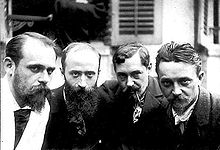
In 1892, he became a member of Les Nabis, a semi-secret, semi-mystical group of young artists, more often than not from the Académie Julian, which included Pierre Bonnard, Ker-Xavier Roussel, Maurice Denis, and Édouard Vuillard, with whom Vallotton was to form a lifelong friendship.[ix] While the Nabis shared certain common ideas and goals, their styles were quite different and personal. He kept himself somewhat apart from the others, earning his jocular title among the Nabis equally "The Foreign Nabi".[10] Vallotton's paintings in this flow reflected the style of his woodcuts, with flat areas of color, difficult edges, and simplification of detail. His subjects included genre scenes, portraits and nudes. Examples of his Nabi style are the deliberately bad-mannered Bathers on a Summer Evening (1892–93), now in the Kunsthaus Zürich, and the symbolist Moonlight (1895), in the Musée d'Orsay.
His paintings began to be noticed by the public and critics; Bathers on a Summer Evening, presented at the Salon des Indépendents, was met with harsh criticism and laughter.[10] Simply his woodcuts attracted attention and clients, and he became financially secure. Between 1893 and 1897, he received many commissions for illustrations from notable French newspapers and magazines, including La Revue Blanche, and from foreign fine art publications, including The Chap-Book of Chicago. He likewise fabricated woodcuts for the covers of theater programs and book illustrations. One of his prominent patrons was Thadée Natanson, the publisher of the Revue Blanche, and his wife Misia, who commissioned many important decorative works from the Nabis. Through the Natansons Vallotton was introduced to the advanced aristocracy of Paris, including Stéphane Mallarmé, Marcel Proust, Eric Satie, and Claude Debussy.[11]
His woodcut subjects included domestic scenes, bathing women, portrait heads, and several images of street crowds and demonstrations—notably, several scenes of police attacking anarchists. He unremarkably depicted types rather than individuals, eschewed the expression of stiff emotion, and "fuse[d] a graphic wit with an acerbic if not ironic humor".[12] Vallotton's graphic art reached its highest evolution in Intimités (Intimacies), a series of 10 interiors published in 1898 by the Revue Blanche, which deal with tension between men and women.[thirteen] Vallotton's woodcuts were widely disseminated in periodicals and books in Europe as well as in the Us, and take been suggested as a pregnant influence on the graphic fine art of Edvard Munch, Aubrey Beardsley, and Ernst Ludwig Kirchner.[14]
In 1898 he bought a Kodak no.ii 'Bullet' and experimented with it equally a ground for at to the lowest degree v interior paintings. His first photos were taken in: Chateau d'Etretat, Chateau de la Naz, the Natanson's summer house above Cannes, and the Villa Beaulieu in Honfleur. Fine art historian Anca I Lasc suggests Woman in Blue Rummaging Through a Cupboard (1903) was based on a photo taken in Vallotton's own Paris dwelling on Rue Milan or rue de Belles Feuilles. Therefore, his paintings were most probable based on existent interiors.[15]
By 1900, the Nabis had drifted autonomously. One source of the division was the Dreyfus affair, the example of a Jewish army officeholder falsely defendant of aiding the Germans. The Nabis were divided, with Vallotton passionately defending Dreyfus. He produced a series of satirical woodcuts on the affair, including The Age of the Newspaper, which were published on the offset page of Le Cri de Paris on January 23, 1898, at the acme of the thing.[16]
Another major outcome during this catamenia was his wedlock in 1899 to Gabrielle Rodrigues-Hénriques, the widowed daughter of Alexandre Bernheim, one of the about successful art dealers in Europe and founder of the Galerie Bernheim-Jeune. The spousal relationship brought to his household three children from her previous matrimony.
At that place are few interiors past Vallotton that prove children except for Dinner past Lamplight showing stepson Max, stepdaughter Madeline, with Gabrielle on his right with the dorsum of the own artist's head.[15]
After a brief honeymoon in Switzerland, they moved to a big apartment on virtually the Gare Saint-Lazare railroad train station. The marriage brought him financial security, and he gradually abandoned woodcuts as his primary source of income. He besides established a solid relationship with the Bernheim family unit and their gallery, which presented a special exhibition devoted to the Nabis, including ten of his works. Thereafter he devoted his attention almost entirely to painting.[16]
-
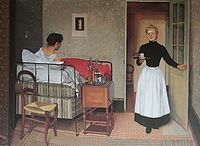
The Patient (1892), individual collection
-

-

La Chambre rouge (1898), tempera on board
-
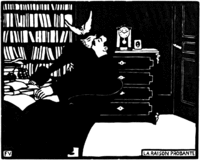
La raison probante (The Cogent Reason), a woodcut from the serial Intimités (1898)
-

The Laundress, Blue Room (1900)
-

Cloud in Romanel (1900)
Afterward the Nabis (1901–1914) [edit]
In the years after the Nabis, the reputation of Vallotton grew. In January 1903, he presented a option of his works at exposition of painters of the Vienna Secession, and sold several works. In May 1903, the Bernheim gallery gave him a i-man testify, which brought him skilful reviews. At the end of the year, the French government made its first buy of 1 of his paintings for the Luxembourg Museum, then Paris's leading museum of modern art.
Despite his successes, his financial situation was notwithstanding precarious. He experimented for a time with sculpture. He connected to publish occasional art criticism, in addition to other writings. He wrote eight plays, some of which received performances (in 1904 and 1907), although their reviews appear to have been unfavorable.[17] He too wrote three novels, including the semi-autobiographical La Vie meurtrière (The Murderous Life), begun in 1907 and published posthumously.[eighteen]
His fortunes changed for the amend at the beginning of 1907, with a show at the Bernheim-Jeune Gallery and the sale of thirteen paintings. He also presented a painting, Three women and a girl playing in the water, at the Salon of the Société des Artistes Indépendants, which received good reviews. He fabricated a trip to Italy with Gabrielle, and on his return painted The Turkish Bath, which was praised by among others the poet and critic Guillaume Apollinaire.[19]
Vallotton'south paintings of the mail service-Nabi menses had admirers, and were generally respected for their truthfulness and their technical qualities, but the severity of his style was frequently criticized.[twenty] Typical is the reaction of the critic who, writing in the March 23, 1910 issue of Neue Zürcher Zeitung, complained that Vallotton "paints like a policeman, like someone whose job it is to catch forms and colors. Everything creaks with an intolerable dryness ... the colors lack all joyfulness."[21] In its uncompromising character his fine art prefigured the New Objectivity that flourished in Germany during the 1920s, and has a farther parallel in the piece of work of Edward Hopper.[22]
In 1912 the French government offered him the Legion of Honor, but like his fellow Nabis Pierre Bonnard and Édouard Vuillard, he refused the honour.
-

Three Women and a Little Daughter Playing in the Water (1907)
-

Honfleur dans la brume (Honfleur in the Mist), 1911
-

Blooming Fields (1912)
-

Cocky-portrait (1914)
The Get-go World State of war and last years (1915–1925) [edit]
The Swiss Vallotton had been naturalized every bit a French citizen in 1900. When Earth War I began in August 1914, he volunteered for the army. He was rejected because of his age (forty-viii), but did what he could do for the war effort. In 1915–sixteen he returned to the medium of woodcut for the offset time since 1901 to express his feelings for his adopted country in the series, This is State of war, his final prints.[23] [24] In June 1917, the Ministry of Fine Arts sent him, along with 2 other artists, for a three-week bout of the forepart lines. The sketches he produced became the basis for a grouping of paintings, The Church of Souain in Silhouette amid them, in which he recorded with cool detachment the ruined landscape.[25] The works made past the 3 artists were presented at the Musée du Grand duchy of luxembourg.[nineteen] [26]
After the end of the war, Vallotton concentrated specially on even so lifes and on "composite landscapes", landscapes composed in the studio from memory and imagination, and on flamboyantly erotic nudes. He had persistent health bug, and he and his wife passed the winters in Cagnes-sur-Mer in Provence, where they bought a modest firm, and Honfleur in Normandy, where they had a summer business firm. By the end of his life he had completed over 1700 paintings and near 200 prints, in addition to hundreds of drawings and several sculptures.[27] He died on the twenty-four hours subsequently his 60th birthday, post-obit cancer surgery in Paris in 1925.
A retrospective exhibition past the Salon des Indépendants took identify in 1926. Some of Vallotton'south works were exhibited at the Grand Palais, along with works by van Gogh, Modigliani, Seurat, Toulouse-Lautrec, Schützenberger and others.[28]
Vallotton'southward brother Paul was an fine art dealer and founded the Galerie Paul Vallotton in Lausanne in 1922, which continued functioning for many years under the control of his descendants. Vallotton's niece was Annie Vallotton, the illustrator of the Expert News Bible.
-
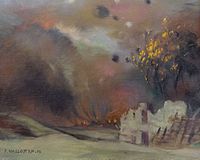
War (Written report), 1915
-

Le Bois de la Gruerie et le ravin des Meurissons (1917)
-

Landscape (1918)
-
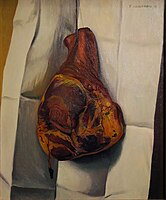
The Ham (1918)
-

La plage à Honfleur (1919)
-

Tulips (1920)
-

Alyscamps Morning Lord's day (1920)
-

-

Self-portrait (1923)
Paintings [edit]
Paris scenes [edit]
During his Nabi menstruum in the 1890s, Vallotton was living largely from the income he made making illustrations for fashion magazines and popular novels, He created a series of paintings chosen Scenes of the Paris streets probably for a novel by Octave Uzane called Les Rassemblements. The paintings, using tempera on paper-thin, used the Nabi trademark method of flat areas of colour, as the Nabi-influenced use of aerial and other unusual perspectives taken from Japanese prints. These works also expressed his social and political attitudes, contrasting the workers struggling to bear heavy sacks with the fashionable women in bright colors carrying wrapped packages from the new Paris department stores. He captured the activity and color within Bon Marché and the other new Paris department stores. His street scenes were filled with activeness and movement, capturing small scenes that appealed to his sense of humour or irony.[29]
-

At the Market (1887)
-

Bon Marché (1898), correct panel of a triptych showing shoppers in a department shop
-

Place Clichy (1901)
Landscapes and seascapes [edit]
Vallotton's landscapes and seascapes avoided conventional views and techniques, and presented unusual viewpoints and perspectives. The scene is sometimes seen from above, with the horizon very high in the picture, or without the heaven being visible at all. The forms are simplified, and the figures are often small and almost unrecognizable. In his famous The Ball of 1899 (Musée d'Orsay), the scene is viewed from above, with three tiny figures: a girl chasing a ball and two mysterious figures in the distance having a conversation. The drama in the picture is the dissimilarity betwixt the sunlight and the shade.[thirty] In his 1899 painting of laundresses drying clothes on the beach of Étretat, the women are almost unrecognizable as such until the picture is examined closely. He wrote in his journal, "I dream of a painting entirely disengaged from any literal business nigh nature. I want to construct landscapes entirely based on the emotions that they accept created in me, a few evocative lines, one or two details, chosen, without a superstition of the exactitude of the hour or the lighting."[31]
-

Laundresses at Étratat (1899)
-
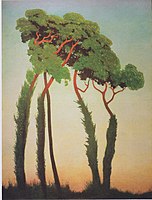
Last rays of sunshine (1911)
-
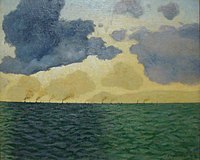
The Rade of Le Havre (1918)
-
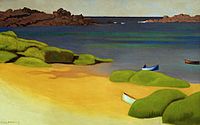
The Bay of Trégastel (1917)
Interiors [edit]
Many of Vallotton's paintings depicted interior apartment scenes, usually with men and women, sometimes hinting at scandal or adultery, sometimes elementary scenes such as taking sheets out of a linen cupboard. The paintings often depicted open doorways or open up doors leading to bedrooms. His wife Gabrielle appeared in many of the paintings, and the apartments resembled his own on rue des Belles-Feuilles. This theme is exemplified past his painting Haut de Forme (1887), and was near frequent in his work betwixt 1898 and well-nigh 1904.[32]
-

The Red Chamber (1898), tempera on board
-

Adult female searching in a wardrobe (1901)
-
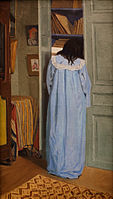
Woman in blueish looking in a closet (1903)
-
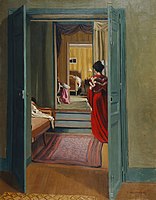
Interior with women in scarlet robe (1904)
The female nude [edit]
The female person nude was a very common subject field for Vallotton; his journal records well-nigh five hundred paintings in this genre. The early nudes, when he was with the Nabis, were stylized and simplified. Afterwards, the paintings became more than detailed and realistic. The decor in the paintings was minimal. The pick of colors—particularly the utilise of complementary cherry-red and green—emphasizes the paleness of the model's skin. There is no effort to make the models romantic or beautiful, and they never smile.[33]
-

The Mistress and the Servant (1896), oil on board, 52 x 66 cm, private collection
-
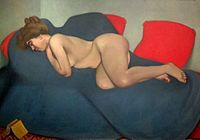
Slumber (1908)
-
-

La Blanche et la Noire (1913)
-
Blonde Nude (1921)
Encounters and Conversations [edit]
Sympathetic to the anarchist movement in his youth, Vallotton was an intense critic of Parisian life and values of the Paris upper class in the Belle Epoch. In the 1890s as a Nabi, he contributed many satirical illustrations to radical revues such as Assiette au beurre and Le Cri de Paris. His paintings in that decade included The Prevarication and The Buss, depicting the hypocrisy and brutality men could show towards women. His political attitudes changed somewhat in 1899 when he married Gabrielle Rodrigues-Hénriques, a member of a wealthy family, and he constitute himself a member of the class he was accepted to condemn.[34]
Despite his new position, he continued his social criticism. Vallotton painted numerous scenes of intimate conversations between men and women, sometimes in restaurants, sometimes at the theater—often scenes suggesting seduction, rarely scenes suggesting romance or dear. They expressed his satirical view of life in Paris at the time. The critic Octave Mirbeau described the figures in this particular genre of Vallotton's paintings in 1910: "....the figures don't merely smile and cry, they speak...they limited strongly, with the most moving eloquence, when information technology is Monsieur Vallotton who hears them speak, their humanity and the character of their humanity."[35] The Provincial (1909) depicts a woman in a bar seducing a provincial visitor to Paris.
-
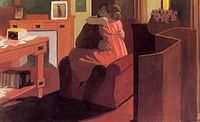
Interior with Couple and Screen (Intimacy), 1898, tempera on board
-

The Provincial (1909)
-

Box Seats at the Theatre, the Gentleman and the Lady (1909)
-

Celibate Suzanne (1922)
Notwithstanding lifes [edit]
In his later years, painting in his studio in Honfleur, he concentrated peculiarly on still lifes, especially flowers, fruits and vegetables, very carefully arranged and painted with extreme precision. He used very vivid colors and was especially meticulous in painting the reflections of light on the fruits, vegetables, and ceramic vases. He wrote in his journal on August 13, 1919: "More ever the object amuses me; the perfection of an egg; the moisture on a love apple; the hit (martelage) of a hortensia flower; these are the bug for me to resolve."[36]
-

However life with capucines (1923)
-

Onions and a soup tureen (1925)
Portraits [edit]
Vallotton was recognized every bit a very accomplished portrait painter, and painted portraits of many of the leading figures in the arts of his time. His early work included a portrait of his beau Nabi Édouard Vuillard. The portraits of Vallotton featured both precision and a certain cold realism. He painted the historic American art patron Gertrude Stein the year after Pablo Picasso fabricated his Portrait of Gertrude Stein, and depicted her as seemingly without emotion.
One of his tardily portraits, The Roumanian in a scarlet dress (1925) acquired a minor scandal. The portrait of Mado Leviseano, a Paris prostitute, shows her slumped in her chair, with a nonchalant and provocative expression. Speaking of portraits in full general, Vallotton wrote: "Human bodies, like faces, have their own individual expressions, which reveal, past their angles, their folds, their wrinkles, the joy, the pain, the boredom, the worries, the appetites, and the physical disuse imposed by work, and the corrosive bitterness of voluptuousness."[ citation needed ] After the death of Vallotton, the work was donated by his family unit to the Luxembourg Museum, the near important museum of modern fine art in Paris at the time. Only visitors to the museum complained about the woman's posture and facial expression, and after three years it was taken down. His widow battled to have information technology restored to view, and the Paris museums took it back. It now is in the collection of the Musée d'Orsay.[37]
-

Portrait of Alexandre Natanson (1899), Musée d'Orsay
-

-

Roumanian in a Red Dress (1925), Musée d'Orsay
Woodcuts [edit]
In the western earth, the relief print, in the form of commercial forest engraving, had long been utilized mainly every bit a means to accurately reproduce fatigued or painted images and, in afterward years, photographs. Vallotton'southward woodcut mode was novel in its starkly reductive opposition of large masses of undifferentiated black and areas of unmodulated white. Vallotton emphasized outline and flat patterns, and generally eliminated the gradations and modeling traditionally produced past hatching. He was influenced past mail service-Impressionism, Symbolism, and specially past the Japanese woodcut: a big exhibition of ukiyo-e prints had been presented at the École des Beaux-Arts in 1890, and Vallotton, who was similar many artists of his era an enthusiast of Japonisme, collected these prints.[38]
-

Self portrait, 1891
-

-

-

-

Notes and citations [edit]
- ^ Rousseau and Protais 2013, p. 3
- ^ St. James 1978, p. 6
- ^ a b Rousseau and Protais 2013, pp. 10–eleven
- ^ Rousseau and Protais 2013, p. 12
- ^ a b Rousseau and Protais 2013, pp. 12–13
- ^ Rousseau and Protais 2013, p. 16
- ^ St. James 1978, p.v
- ^ Ducrey & Vallotton 2007, p. twoscore
- ^ Newman 1991, p. 262
- ^ a b Rousseau and Protais 2013, p. 19
- ^ Rousseau and Protais 2013, p. 20
- ^ Newman 1991, pp. 43–45
- ^ Newman 1991, p. 76
- ^ St. James 1978, p. 24
- ^ a b Visualizing the nineteenth-century abode : modern art and the decorative impulse. Lasc, Anca I. London. 2016. ISBN9781472449634. OCLC 922971025.
{{cite book}}: CS1 maint: others (link) - ^ a b Rousseau and Protais 2013, p. 23
- ^ Ducrey 1989, p. thirty
- ^ Newman 1991, p. 318
- ^ a b Rousseau and Protais 2013, p. 28
- ^ Ducrey 1989, p. 12
- ^ quoted in Newman 1991, p. 290
- ^ Newman 1991, p. forty
- ^ Newman 1991, pp. 195, 266
- ^ St. James 1978, p. 26
- ^ Newman 1991, p. 200
- ^ Newman 1991, p. 193
- ^ Ducrey & Vallotton 2007, pp. 7–eight
- ^ Le Bulletin de la vie artistique (Paris), 1926-02-xv, p.53, BnF
- ^ Rousseau and Protais (2013), p. 44
- ^ Rousseau and Protais (2013), pg. 64
- ^ cited in Rousseau and Protais (2013), pg. 64
- ^ Cahn, Félix Vallotton, Decouvertes, (2013)
- ^ Rousseau and Protais 2013, p. 106
- ^ Rousseau and Protais, (2013) p. 58
- ^ Cited by Isabel Kahn, Félix Vallotton (2013)
- ^ Cited in Cahan, Isabelle, Félix Vallotton (2013)
- ^ Rousseau and Protais (2013), p. 116
- ^ St. James 1978, pp.seven–9
References [edit]
- Brodskaïa, Nathalia (1996). Félix Vallotton: The Nabi from Switzerland. Bournemouth: Parkstone. ISBN 1-85995-202-X
- Cahn, Isabelle (2013), Félix Vallotton, Découvertes, Gallimard/RMN Grand Palais, Paris (in French) ISBN 978-2-07-014212-5
- Ducrey, Marina (1989). Félix Vallotton: His Life, His Technique, His Paintings. Lausanne: Edita SA. ISBN two-88001-248-ane
- Ducrey, Marina, & Vallotton, Felix (2007). Vallotton. Milan: 5 continents. ISBN 978-88-7439-420-3
- Frèches-Thory, Claire, & Perucchi-Petry, Ursula, ed.: Die Nabis: Propheten der Moderne, Kunsthaus Zürich & Grand Palais, Paris & Prestel, Munich 1993 ISBN 3-7913-1969-8 (German language), (French)
- Newman, Sasha 1000., Félix Vallotton, Marina Ducrey, and Lesley One thousand. Baier (1991). Félix Vallotton. New Oasis: Yale University Art Gallery. ISBN 1-55859-312-8
- Rousseau, Éloi and Protais, Johann, (2013), Les plus belles oeuvres de Vallotton, Éditions Larousse, Paris, ISBN 978-2-03-589627-8
- St. James, Ashley (1978). Vallotton: Graphics. London: Ash & Grant Ltd. ISBN 0-904069-nineteen-2
External links [edit]
- List of paintings by Vallatton in Wikidata
- Works by Félix Vallotton at Project Gutenberg
- Works past or about Félix Vallotton at Internet Annal
- The main works of Félix Vallotton
- Félix-Vallotton.com (French)
- Vallotton Gallery at MuseumSyndicate
- Vallotton engraver : analyse of La Manifestation, wood cut, 1893. (French)
- Works by Félix Vallotton at Zeno.org (German)
- The Prodigious Century
- Félix Vallotton in American public collections, on the French Sculpture Census website

Source: https://en.wikipedia.org/wiki/F%C3%A9lix_Vallotton
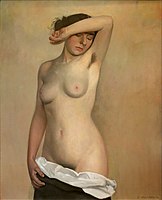

0 Response to "French 19th Century Painting of a Middle Class Family"
Post a Comment